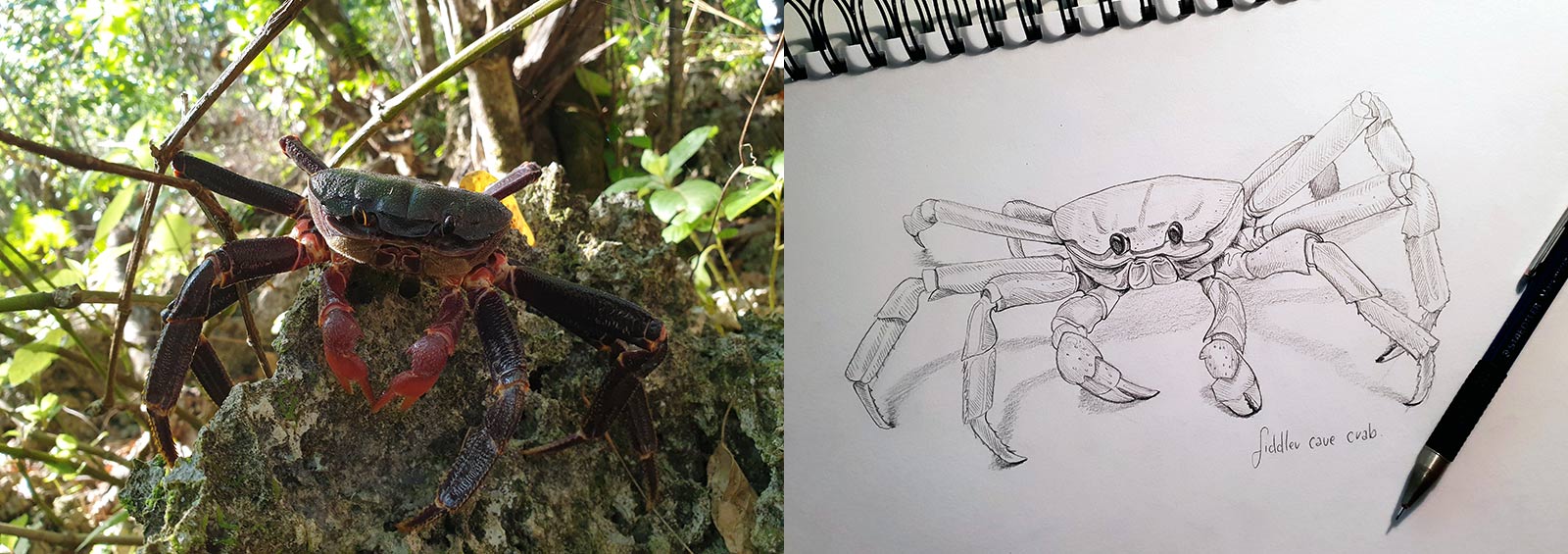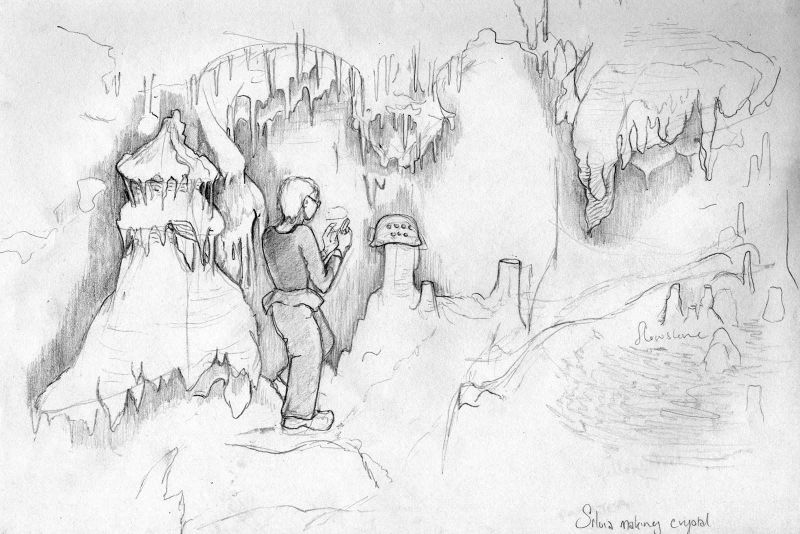Conjoint Professor Frisia, of the University of Newcastle’s School of Environmental and Life Sciences, is a leading authority in the study of caves as they relate to climate change.
And while Atiu perhaps best known as being home to birds such as the Kopeka, as well as growing some of the best Arabica coffee beans in the world, it’s also a cave-lover's haven. So in 2019, Professor Frisia led a research trip the Cook Islands Archipelago.
“Our group of students was keen to learn about past cyclones and tsunamis, and eagerly collected waters dripping from stalactites for my little experiments in the cave that tell me how stalagmites capture rainfall,” Professor Frisia says.
However, while the crew who came along included the likes of fellow cave expert Dr Andrea Borsato and paleoclimate PhD student Ali Faraji, Professor Frisia saw the opportunity for interdisciplinary collaboration.
Which is how Natural History Illustration student Nikki Pierce – who was completing her third-year major works, a series looking at coral reefs – came to be part of the expedition.

“Having a natural history illustrator with us was fantastic,” Professor Frisia says.
“Nikki documented meticulously our scientific research and her drawings say more than a thousand words… Or ten thousand!”
The cross-disciplinary team spent their days in equally diverse pursuits, hiking through the tropical wilderness, immersing themselves in the rich culture, strapping on snorkels to explore the ancient, raised coral reef that surrounds the island, and swapping facemasks for headlamps to illuminate their trips into the island’s caves.
It was here, in the caves, that Professor Frisia undertook her research, seeking to understand what drives rainfall in this part of the world – and why it is changing now – by interrogating past climate records preserved in stalagmites.
"This is important, because the past is the key for predicting future climate," Professor Frisia explains.
"We look at layers in the stalagmites that are invisible to the naked eye, but we can see these layers by using light generated by a powerful instrument in Melbourne: the Australian Synchrotron.
“This reveals less than one-millimetre-thin changes in the composition of the stacked crystals that form each year. Then we can produce a very long, yearly record of rainfall change.”
Nikki had a slightly humbler instrument to document the process: a pencil. Nonetheless, the scientist found the artist’s presence invaluable.
“Nikki sketched all I did asking questions and questions," Professor Frisia says.
“Nikki became my teacher, helping me to tell a complex story in a simple way.”

Nikki's field drawing of Silvia in the cave

Nikki's field drawing of a cave

Nikki's field drawing of stalactites

Chemical maps in a stalactite

Nikki's image of a stalactite in a cave
For her part, Nikki says that the experience showed “that here at the University we are at the forefront of climate research”, but also that a challenge of such magnitude requires a multi-pronged approach.
“The collective challenge of climate change is not confined to the disciplines through which we investigate its effects," Nikki says.
“To address the complexities of a rapidly changing climate, we need solutions that are innovative, creative and that allow us to communicate effectively across disciplines.
“This inspired me to research and explore the bridges between art and science, so that we might better work together despite our 'different' expert languages and ways of viewing the world."
Following their return to Newcastle, the opportunity arose for Professor Frisia and Nikki to submit their work to PAGES – a Swiss-based organisation that “supports research which aims to understand the Earth’s past environment in order to obtain better predictions of future climate and environment”.
But rather than submit to PAGES’ existing publication, the duo decided their work was perhaps better suited to the organisation’s recently announced Horizons magazine, which aims to speak about climate issues directly to a younger audience.
“That was when I had the idea that it would be great to transform the whole experience into something for everyone to enjoy,” Professor Frisia says.
To assist getting the tone right for this younger audience, Professor Frisia recruited Dr Pauline Treble – who is the mother of two teenagers and, admits Professor Frisia, “I needed someone who is familiar with teenagers” – as co-author.
The outcome is a cross-disciplinary piece of work, published in the inaugural edition of Horizons, that explains Professor Frisia’s research in the Cook Islands through both accessible but intelligent copy as well as Ms Pierce’s warm yet extremely detailed illustrations.

Truck in the Cook Islands

Stalactites in a cave

Research team in a cave in the Cook Islands

A pool of water in the cave

Large stalactite cross-section

Person with a red hat heading to the beach

Woman taking a selfie while snorkelling
“This is evidence that here at the University, there is enormous potential to combine art and science to achieve one of the hardest tasks: making difficult scientific concepts available to anyone,” says Professor Frisia.
“We want people to know that science is not a cumbersome thing only ‘intelligent’ University people can do. It is a narrative, a story, a beautiful world accessible to all those who want to change life for the better.”
So what’s next for our intrepid explorers slash authors?
“Our next step is to find why the rain changed, which is important to help communities in the South Pacific to face the effects of climate change,” Professor Frisia says.
As for the recently-graduated Nikki? Another trip to the Cook Islands is high on the priorities list, with the artist saying the island nation is "first on my list of countries to visit when international travel restrictions ease!”
All photos and images courtesy of Nikki Pierce.